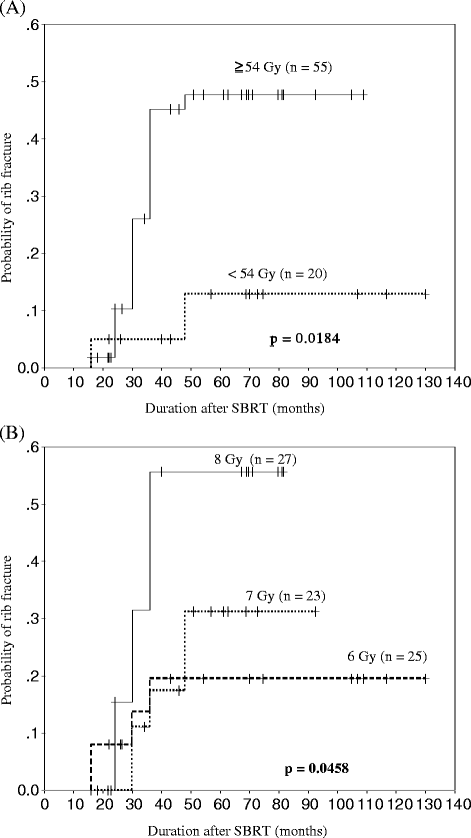Radiation-induced rib fracture after stereotactic body radiotherapy with a total dose of 54-56 Gy given in 9-7 fractions for patients with peripheral lung tumor: impact of maximum dose and fraction size
- PMID: 25897487
- PMCID: PMC4465155
- DOI: 10.1186/s13014-015-0406-8
Radiation-induced rib fracture after stereotactic body radiotherapy with a total dose of 54-56 Gy given in 9-7 fractions for patients with peripheral lung tumor: impact of maximum dose and fraction size
Abstract
Background: Radiation-induced rib fracture after stereotactic body radiotherapy (SBRT) for lung cancer has been recently reported. However, incidence of radiation-induced rib fracture after SBRT using moderate fraction sizes with a long-term follow-up time are not clarified. We examined incidence and risk factors of radiation-induced rib fracture after SBRT using moderate fraction sizes for the patients with peripherally located lung tumor.
Methods: During 2003-2008, 41 patients with 42 lung tumors were treated with SBRT to 54-56 Gy in 9-7 fractions. The endpoint in the study was radiation-induced rib fracture detected by CT scan after the treatment. All ribs where the irradiated doses were more than 80% of prescribed dose were selected and contoured to build the dose-volume histograms (DVHs). Comparisons of the several factors obtained from the DVHs and the probabilities of rib fracture calculated by Kaplan-Meier method were performed in the study.
Results: Median follow-up time was 68 months. Among 75 contoured ribs, 23 rib fractures were observed in 34% of the patients during 16-48 months after SBRT, however, no patients complained of chest wall pain. The 4-year probabilities of rib fracture for maximum dose of ribs (Dmax) more than and less than 54 Gy were 47.7% and 12.9% (p = 0.0184), and for fraction size of 6, 7 and 8 Gy were 19.5%, 31.2% and 55.7% (p = 0.0458), respectively. Other factors, such as D2cc, mean dose of ribs, V10-55, age, sex, and planning target volume were not significantly different.
Conclusions: The doses and fractionations used in this study resulted in no clinically significant rib fractures for this population, but that higher Dmax and dose per fraction treatments resulted in an increase in asymptomatic grade 1 rib fractures.
Figures



References
-
- Nagata Y, Negoro Y, Aoki T, Mizowaki T, Takayama K, Kokubo M, et al. Clinical outcomes of 3D conformal hypofractionated single high dose radiotherapy for one or two lung tumors using a stereotactic body frame. Int J Radiat Oncol Biol Phys. 2002;52:1041–6. doi: 10.1016/S0360-3016(01)02731-6. - DOI - PubMed
-
- Fukumoto S, Shirato H, Shimzu S, Ogura S, Onimaru R, Kitamura K, et al. Small-volume image-guided radiotherapy using hypofractionated, coplanar, and noncoplanar multiple fields for patients with inoperable stage I nonsmall cell lung carcinomas. Cancer. 2002;95:1546–53. doi: 10.1002/cncr.10853. - DOI - PubMed
MeSH terms
LinkOut - more resources
Full Text Sources
Other Literature Sources
Medical

